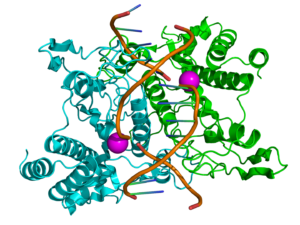Restriction enzymes sometimes get a lot of flak. In the not-so-distant past, they were the workhorses of molecular biology. Restriction enzymes played a huge role in developing early DNA sequencing techniques. They chop DNA in a predictable manner, which makes cutting and pasting genes of interest manageable and relatively easy, enabling the development of genetic engineering and recombination technologies. These technologies are now moving beyond restriction enzymes toward more modern methods, with the most talked-about method being CRISPR /Cas9. As technology continues to advance at such a rapid pace, restriction analysis and other “ancient” technologies feel antiquated. But this is not necessarily the case.
In a paper published in 1975, Sambrook, et al. described their method for determining results of cross-over events during viral recombination and locating where in the DNA mutations arose. This was done by exposing viral DNA to different conditions, digesting that DNA with restriction enzymes, and finally, running the digested DNA on an agarose gel to determine the sizes of the digested DNA fragments. Because each restriction enzyme cuts DNA at a nucleic acid sequence specific to that enzyme, the scientists were able to put together the puzzle of DNA fragments and compare fragment sizes of mutated DNA to fragment sizes of control DNA. This became known as Restriction Fragment Length Polymorphism (RFLP). RFLP can be used to look closely at the variety of species present microbial communities.
The co-founder of MTV, Tom Freston, once said, “Innovation is taking two things that already exist and putting them together in a new way.” As biotechnology progressed and PCR became more widespread, Terminal Restriction Fragment Length Polymorphism (TRFLP) was developed. TRFLP combines RFLP with PCR for a more focused study on a specific gene or sequence target. TRFLP can be put to good use in a variety of ways including determination of risk for disease, detection of genetic disorders, and bacterial and fungal species identification.
The development and advancement of DNA and RNA sequencing seems to have displaced the need for RFLP in microbial fingerprinting. However, DNA and RNA sequencing is expensive and data analysis is especially time-consuming. Sequencing can be great in situations where money and time are not an issue. But it may not be the best choice in situations where easy and fast is more desirable, such as observation of microbial communities over time. In these situations, TRFLP could be a more reasonable and attractive choice. An article published in Nature: Science Reports by Vrieze et al. discusses one such situation: for the monitoring of microbial communities during anaerobic digestion, which is important for natural waste management from backyard composting to wastewater treatment.
For proper breakdown of materials, the microbial communities must contain the appropriate ratios of desired microbes. Vrieze and his team wanted to compare methods for determining the microbial diversity in anaerobic digestion communities, specifically focusing on 16S rRNA sequencing vs TRFLP. They found that although TRFLP is not as useful as sequencing for determination of detailed microbial community profiles, it is very useful for quick and more affordable screening of microbial communities when frequent monitoring is desired.
They concluded, “Briefly, TRFLP is not at all obsolete, and will remain of high value in the field of microbial ecology.”
If your research takes you in the direction of restriction enzyme digestion, check out our resources. We have a calculator available as a web tool (or as iOS and Android apps) that can help you plan your digestion reaction. Our Subcloning Notebook provides some basics on restriction enzyme digestion as well. And you can explore our restriction enzyme offerings here.
Latest posts by Leah Cronan (see all)
- Mass Spec for Glycosylation Analysis of SARS-CoV-2 Proteins Implicated in Host-Cell Entry - November 10, 2020
- Proteomics from a Different Point of View: Introducing ProAlanase, the Newest Mass-Spec Grade Protease from Promega - August 7, 2020
- Go fISH! Using in situ Hybridization to Search for Expression of a SARS-CoV-2 Viral Entry Protein - July 10, 2020

